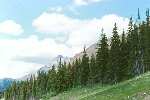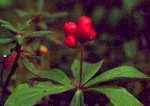









|
|
The Subalpine Vegetation
 The Subalpine is often divided into two portions - a Lower Subalpine characterized by closed forests of lodgepole pine, Engelmann spruce and subalpine fir, and an Upper Subalpine with spruce-fir closed forests and open forests near the treeline. The spruce at lower elevations is often an introgressive hybrid between white spruce and Engelmann spruce. At higher elevations, pure Engelmann spruce is characteristic. The Subalpine is often divided into two portions - a Lower Subalpine characterized by closed forests of lodgepole pine, Engelmann spruce and subalpine fir, and an Upper Subalpine with spruce-fir closed forests and open forests near the treeline. The spruce at lower elevations is often an introgressive hybrid between white spruce and Engelmann spruce. At higher elevations, pure Engelmann spruce is characteristic.
 At lower elevations in the Subalpine Subregion, lodgepole pine forests cover extensive areas following fire. Common understory species include buffaloberry, hairy wild rye, showy aster, bearberry, junipers, and bunchberry. At higher elevations, false azalea and grouseberry are important. In the south, thimbleberry, western snowberry, and Rocky Mountain maple are also important. At lower elevations in the Subalpine Subregion, lodgepole pine forests cover extensive areas following fire. Common understory species include buffaloberry, hairy wild rye, showy aster, bearberry, junipers, and bunchberry. At higher elevations, false azalea and grouseberry are important. In the south, thimbleberry, western snowberry, and Rocky Mountain maple are also important.
Engelmann spruce-subalpine fir forests typically occur on higher, moister sites that have not been as subject to fire as the lodgepole pine forests. These forests occupy a wide variety of landforms and environmental conditions. Typical understory
species include false azalea, huckleberry, white-flowered rhododendron, grouseberry, one-flowered wintergreen, bunchberry and one-sided wintergreen. Older, mesic forests also tend to have a thick carpet of mosses and lichens.
The understory of the forests of the Waterton Lakes National Park area contains a number of species that do not occur further north. These include beargrass, thimbleberry, Piper's wood rush, foam flower and mountain lover.
Open forests in the Upper Subalpine are transitional to the treeless Alpine Subregion above. Dominant trees include Engelmann spruce, subalpine fir, whitebark pine and, south of Bow Pass, subalpine larch. Forests with herbaceous understories are dominated by arrowleaf groundsel, subalpine fleabane, mountain valerian, western anemone and mountain hairgrass. Other forests contains dwarf shrubs which also occur in the Alpine Subregion including red heather, yellow heather, white mountain heather, grouseberry, and rock willow.
 High elevation grasslands occur in the Subalpine, mostly on steep, southerly and westerly aspects in the Front Ranges. Dominant species include hairy wild rye, June grass, and bearberry. Snow avalanches also create a diverse mix of shrubby and herbaceous communities.
High elevation grasslands occur in the Subalpine, mostly on steep, southerly and westerly aspects in the Front Ranges. Dominant species include hairy wild rye, June grass, and bearberry. Snow avalanches also create a diverse mix of shrubby and herbaceous communities.
Information provided by and printed with the permission of Alberta Community Development,
Provincial Parks and Protected
Areas.
[Geology
and Landforms][Climate][Soils]
[Vegetation][Wildlife]
|














